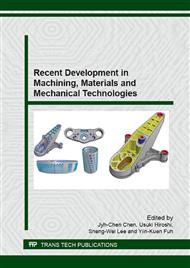p.251
p.255
p.261
p.266
p.271
p.277
p.283
p.289
p.296
Evaluation of Machining Forces in Asymmetrical Face Milling of Cast Iron DIN GGG50
Abstract:
The effects of the feed rate and the axial and radial depth of cut in the up and down asymmetrical face milling with respect to workpiece about the orthogonal components (axial, radial and tangential) of the cutting force in the machining of cast iron DIN GGG50 with carbide inserts was evaluated. The spindle speed was remained constant. The cutting forces were acquired through a sensory system that consists of piezoelectric dynamometer, signal acquisition board and computer with appropriate software. In the end it was concluded that studies of machining forces provides a strong basis for understanding the kinematics and the dynamics of the tool and the cutting operation and it can be applied to optimize the cutting geometries and test the probabilities of tool distortions.
Info:
Periodical:
Pages:
271-276
Citation:
Online since:
July 2015
Authors:
Keywords:
Price:
Сopyright:
© 2015 Trans Tech Publications Ltd. All Rights Reserved
Share:
Citation:


